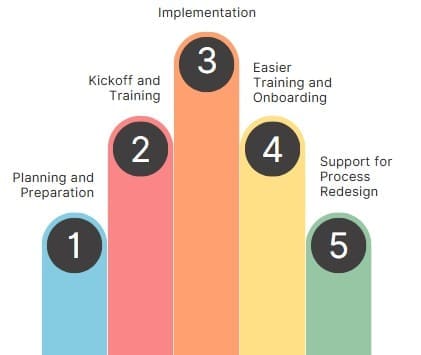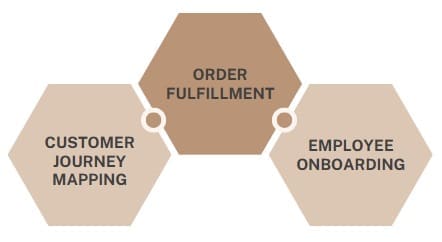Every organization relies on processes to function—whether it’s delivering a service, manufacturing a product, onboarding new employees, or responding to customer queries. These processes often involve several departments, multiple steps, and different tools or systems. But how do you get a clear, big-picture view of everything that happens from start to finish?
That’s where end-to-end process mapping comes in.
End-to-end process mapping is a technique businesses use to visually lay out the full sequence of activities involved in a process. It covers every step from the initial trigger (input) to the final result (output), showing who does what, when, and how.
Unlike traditional process mapping that might focus on just one function or team, end-to-end mapping looks at the entire journey—across departments, systems, and even external partners.
Table of contents
What Is Process Mapping?
At its core, process mapping is a way to visualize how work gets done. It’s a tool that displays the sequence of steps in a process using symbols, arrows, and text. These maps help people understand who does what, in what order, and how tasks relate to one another.
A process itself is a structured group of actions that transforms something—such as data, materials, or customer requests—into a useful output. For example, taking a customer order and delivering the product is a process.
A process map, also known as a process flowchart, makes that invisible work visible. It shows:
- Each step in a process
- Who is responsible
- What decisions need to be made
- How different teams or systems interact
- How inputs become outputs
These maps often read from left to right or top to bottom. If arrows point backward or upward, they usually indicate rework or backtracking—something most businesses want to reduce.
Why Is Process Mapping Important?

There are many reasons why businesses choose to map their processes:
- Faster Onboarding
When new employees join, they need to understand how things work. A documented process map can help them quickly grasp workflows, reducing training time and minimizing confusion. - Clearer Communication
Describing processes with words can be messy and open to interpretation. A visual process map makes it easier to explain tasks, responsibilities, and flows to others—whether they’re team members, clients, or auditors. - Improving and Re-engineering Processes
You can’t fix what you don’t understand. Process maps allow you to spot inefficiencies, bottlenecks, or redundant steps. With that insight, you can redesign processes to make them leaner, faster, and more cost-effective. - Easier Training and Onboarding
New employees can use process maps to understand workflows quickly, without needing to read lengthy documents or rely on word-of-mouth. - Support for Process Redesign
You can’t improve or automate a process unless you fully understand it. Process mapping lays the foundation for changes like automation, outsourcing, or redesign.
What Makes End-to-End Mapping Different?
While general process mapping might focus on a single department or activity, end-to-end process mapping spans the entire lifecycle of a process. This includes every stakeholder, tool, system, and transition—start to finish.
Imagine tracing the journey of a customer order:
- It begins with an online form.
- Then the system sends data to sales.
- Sales confirms and passes it to billing.
- Billing requests payment.
- The warehouse ships the product.
- The customer gets a delivery confirmation.
That’s a full end-to-end process. Mapping it helps everyone understand not just their part, but how everything fits together.
Steps Involved in End-to-End Process Mapping
Here’s a simplified guide to how you can create an effective end-to-end process map:
- Define the Process
Start by identifying the process you want to map. Is it customer onboarding? Invoice processing? Whatever it is, make sure the scope is clear. - Determine the Start and End Points
Specify where the process begins (the trigger) and where it ends (the final output). This helps set boundaries and keeps the map focused. - Gather Information
Talk to people involved in the process. Interview team members, observe tasks in real-time, and review any existing documentation. Everyone involved has valuable input. - List Out the Steps
Break the process into smaller tasks or actions. Note any decisions or conditions that can change the flow (for example: “If payment fails, send reminder”). - Identify Who Does What
Assign each step to the right person, team, or system. This makes roles and responsibilities crystal clear. - Draw the Map
Use simple symbols: boxes for tasks, arrows for flow, diamonds for decisions. Use swimlanes or columns to show which department handles which steps. - Validate and Refine
Test your map. Share it with stakeholders and check for accuracy. Adjust as needed to reflect real-world workflows.
Key Components of an End-to-End Map

To build a useful map, include these basic building blocks:
- Processes – The core actions or workflows from start to finish
- Tasks/Activities – Individual steps completed by people or systems
- Flows – Arrows or lines showing the direction of work or data
- Events – Things that trigger, interrupt, or complete a process
- Gateways/Decisions – Points where a decision changes the path
- Participants – People, departments, or systems doing the work
Types of Process Maps (and Where End-to-End Mapping Fits In)

- Relationship Maps
These give a high-level view of how different departments, suppliers, and customers connect. A common method here is SIPOC (Suppliers, Inputs, Process, Outputs, Customers). It shows who gives what to whom, and what happens in between—but it doesn’t get into the task-by-task detail. - Flowcharts
Flowcharts show the sequence of actions in a process. You can create:- Macro-level flowcharts (big-picture)
- Micro-level flowcharts (detailed actions and decisions)
End-to-end maps often begin as macro-level flowcharts, then expand where necessary.
- Cross-Functional Maps
Also known as swim lane diagrams, these show the flow of activities and how different departments interact. These are especially helpful in end-to-end mapping because they make hand-offs between teams obvious.
What Is SIPOC and Why Is It Useful?
SIPOC is a framework that helps you see the full scope of a process. It’s often used at the start of an end-to-end mapping exercise.
Let’s break it down:
- Suppliers: Who provides the inputs?
- Inputs: What materials, information, or resources are needed?
- Process: What steps are taken to produce the output?
- Outputs: What are the results or deliverables?
- Customers: Who receives the outputs?
Using SIPOC helps identify gaps and clarify expectations early on. For example, if a supplier doesn’t understand input requirements, the whole process can suffer. SIPOC helps prevent that.
Challenges That End-to-End Mapping Solves
- Lack of Visibility
Without a full map, teams often focus only on their part of the process. They don’t see how delays or errors in their area affect the overall flow. - Inefficiencies and Redundancies
Mapping helps you spot unnecessary loops, duplicated steps, and outdated practices. - Poor Communication Across Teams
End-to-end maps clarify handoffs between departments. Everyone can see who is responsible for what, and when. - Process Failures or Breakdowns
Mapping makes it easier to identify points of failure and correct them quickly. It also helps in designing backup plans or automation.
Best Practices for End-to-End Mapping
- Use simple language so everyone understands the map
- Include all stakeholders during the creation process
- Start high-level, then add detail where needed
- Validate with real users—those who do the work daily
- Keep it updated—a process map is only useful if it reflects the current state.
End-to-End Mapping in the Real World

Here are a few examples of where end-to-end process mapping is commonly applied:
- Customer Journey Mapping
From the first contact to post-sale support, mapping the entire customer experience helps improve satisfaction and reduce friction. - Order Fulfillment
From order placement to delivery, end-to-end maps help logistics and operations align perfectly. - Employee Onboarding
Mapping the entire onboarding process—from offer letter to training completion—helps HR deliver a smoother experience for new hires.
Final Words
End-to-end process mapping gives organizations a powerful tool to see the full picture. It doesn’t just show tasks—it reveals relationships, dependencies, and opportunities for improvement. By using this approach, companies can work more efficiently, reduce waste, and provide better service.
It helps teams break out of their silos and understand how their work contributes to the bigger goal. In a world where processes are increasingly complex, having a clear and shared view of how things work—from start to finish—can make all the difference.


















